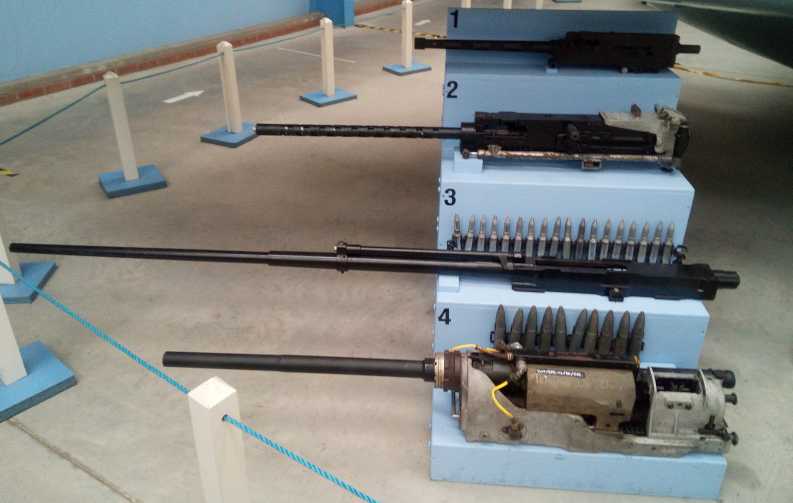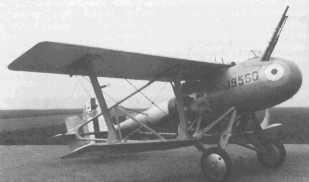Dinger's Aviation Pages
What is the difference between an aircraft machine gun and a cannon?
This is an addition to my page on the gun armament of the RAF in WW2.
This is an addition to my page on the gun armament of the RAF in WW2.

A display of weapons at the Newark Air Museum (UK). At the top, number 1 is the Browning .303 machine gun, and below it, number 2 is the .50 calibre Browning machine gun. Number 3 is the Hispano 20 mm Cannon, and lastly, Number 4 is the post-war 30mm Aden Cannon.
There is no difference in operation or fundamental design between an aircraft machine gun and a cannon other than that cannons are usually designed to fire explosive "shells" and machine guns are usually designed to fire solid "bullets". Today the difference is blurred because many aircraft guns that are classed as "cannons" fire solid armour-piercing projectiles, while all aircraft machine guns can fire incendiary bullets with a small explosive charge and larger calibre machine guns can have explosive ammunition.
So why does the distinction exist? It dates back to the St Petersburg Declaration of 1868 which banned the use of exploding or incendiary rounds in projectiles of less than 400-gram weight (14 ounces). The Russians had developed such an explosive bullet, but sought to avoid an arms race by getting an international agreement to outlaw the use of such weapons. The treaty was agreed upon by all the major European powers¹ but the USA was not invited to attend the conference, so never agreed to the terms of the treaty. Indeed, the USA had already developed and deployed explosive rounds during the American Civil War.
Under the terms of the treaty, only larger weapons could fire explosive rounds. The distinction became that the infantry and cavalry could only use solid bullets, while any explosive or incendiary projectile was the responsibility of the artillery. Although not specified in the St Petersburgh Declaration, it came to be accepted that the minimum calibre gun able to fire explosive shells was 37 mm (1½ inches) ². With the invention of the reliable Maxim machine gun, it became inevitable that it should be scaled up to fire larger, explosive projectiles. This led to the "one-pounder pom-pom gun" that first saw combat service on both sides in the Second Boer War. This weapon was deliberately made to have a 37mm calibre and fired a 450-gram shell so as to avoid being in contravention of the Declaration.
Before World War One the British Royal Aircraft Factory had built a pusher biplane, the FE3, designed to carry a large 37 mm calibre gun developed by the Coventry Ordnance Works (called the "COW" gun) that fired a one pound (454-gram) shell. Again this was a deliberate choice so as to be outside the limits of the Declaration. Although the aircraft was flown, structural problems with its thin boom design meant it was sidelined for other projects. The gun was not ready for use until the very end of the war, by which time it had been redesigned to fired a larger 1-pound 7-ounce shell (650-gram).
During World War One, tracer ammunition types with a small explosive charge and incendiary properties were developed for aircraft-mounted machine guns to attack observation balloons and airships. The Allies deemed it to be against the rules of war to use this ammunition to fire at ground troops, other aircraft, or directly at the crew stations of airships and balloons ³. The smallest of 3 types of the American Davis recoilless gun developed for aircraft use during WW1 fired a 2-pound (910-gram) shell of 40mm calibre, so outside the terms of the St Petersburgh Declaration. The British briefly used the Vickers 1.59 QF gun of 40mm calibre firing a 1.2 Ib (0.54 kg) shell mounted in the nose of FE2b aircraft, again outside the limits of the Declaration. However, the Germans disregarded the St Petersburgh Declaration and deployed the 20mm Beker cannon in use from aircraft and the anti-aircraft role, firing a small 123-gram explosive shell.
The increasing use of metal to build aircraft in the late 1920s and through into the 1930s forced the need for weapons to fire explosive shells to bring them down. The British experimented with the 37mm Coventry Ordnance Works gun "COW" gun on various prototype aircraft, and it briefly saw service on a handful of Blackburn Perth flying boats but it proved too unwieldy for practical use.

The various uses of the "COW" gun in aircraft designs of the late 1920s and early 1930s, such as the Vickers COW gun fighter pictured above, could be seen as a last attempt by the British Air Ministry to come up with a weapon that did not contravene the Saint Petersburgh Declaration.
In the mid-1930s, it seems that most nations just decided to ignore the St Petersburgh Declaration and a series of "cannon" designs to fire explosive shells of smaller calibre appeared. The German 20mm Beker cannon spawned the Swiss Oerlikon cannon which was then adopted back by the Germans as the MG FF. The 20mm Oerlikon gave rise to the French HS404 which then in turn was adopted by the British as the Hispano 20mm cannon. In Denmark, the Madsen company produced cannons in both 20 and 23 mm calibre. In Russia, the ShVAK cannon was produced, first in 12.7 mm (.50 inch) calibre and then in 20mm with shell weights between 96 and 99 grams. At the same time the use of incendiary ammunition for machine guns increased, either as purely incendiary or with a tracer effect.
The Americans used their large calibre .50 inch M2 machine gun mounted on aircraft during WW2 and through into the Korean war. Various types of incendiary ammunition, some with an explosive effect, were developed for it. It should be noted that the Japanese Army used the Ho-103, a reverse-engineered copy of the American .50 M2 machine gun, firing an explosive round with less muzzle-velocity in their aircraft in WW2, although they referred to the weapon as a "cannon". The Italians used explosive rounds for their 12.7mm (0.50 inch) SAFAT and Scotti machine guns. The German 13mm MG131 machine guns used on the later marks of the Bf109 fighter were also provided with exploding ammunition. While the smallest calibre German aircraft gun classed as a "cannon", the 15mm MG151/15, was only slightly larger. This goes to show how the line between the two types of weapons is a purely arbitrary one. To further stress that point, towards the end of WW2 the British largely gave up using explosive shells in their 20mm cannon, preferring to use solid armour-piercing rounds instead, which had a better effect on the type of targets (both aircraft and armoured vehicles) they were then attacking.
Thus it seems that at worst the use of the word "cannon" was a sop to somehow obscure the fact that the terms of the Saint Petersburgh Declaration were being broken. At best it was an indication that the weapon was designed to bring down an aircraft rather than directly kill or wound the crew, although that would inevitably be a likely by-product.
NOTES
¹ Some articles claim the terms of the Saint Petersburgh Declaration were superseded by the Hague Conventions of 1899 and 1907. The Hague Convention of 1899 did expand on the limitations on projectiles, banning "soft-nosed" and "dum-dum" bullets (although the USA, alone among the major nations, refused to ratify that particular convention). However, the Saint Petersburgh Declaration has never been officially revoked, and it is deemed to be still formally binding to the nations that signed it, although it would seem all those countries choose to ignore it after the late 1930s. Technically it is against the declaration to use tracer bullets except for ranging or target marking purposes. The International Red Cross asserts that the Saint Petersburgh Declaration is still in force. Confirmation of this can be read on page 3-5 of their training pamphlet "The Law of Armed Conflict - Weapons", which is available as a PDF file at <this link>.
² The St Petersburgh Declaration does not specify 37mm (1½ inches) as the minimum calibre for exploding shells but to confirm that in the early 1930s, this was still seen as the minimum calibre by the British Air Ministry see chapter 5 (page 117) "the Quest for Fighter Firepower" in Colin Sinnott's book "The RAF and Aircraft Design 1923-39" ISBN 0-7146-5158-3.
³ To confirm that during WW1, British airmen considered it illegal to use incendiary ammunition against aircraft targets, (reserving it only for attacking balloons) - see chapter 6 of Norman Frank's "Dog Fight - Aerial Tactics Of The Aces Of The First World War", ISBN: 978-1-84832-832-7.
Links
Text of the Saint Petersburgh Declaration, in PDF format.
Informative listing of aircraft cannon types.
Text of the Saint Petersburgh Declaration, in PDF format.
Informative listing of aircraft cannon types.
